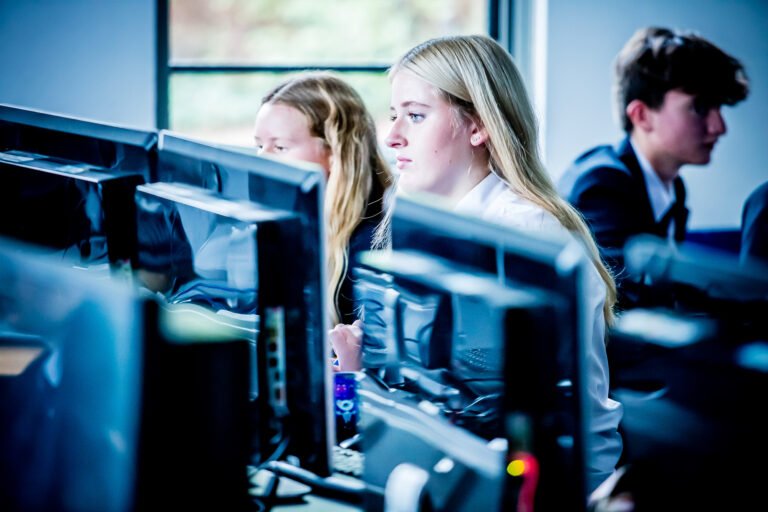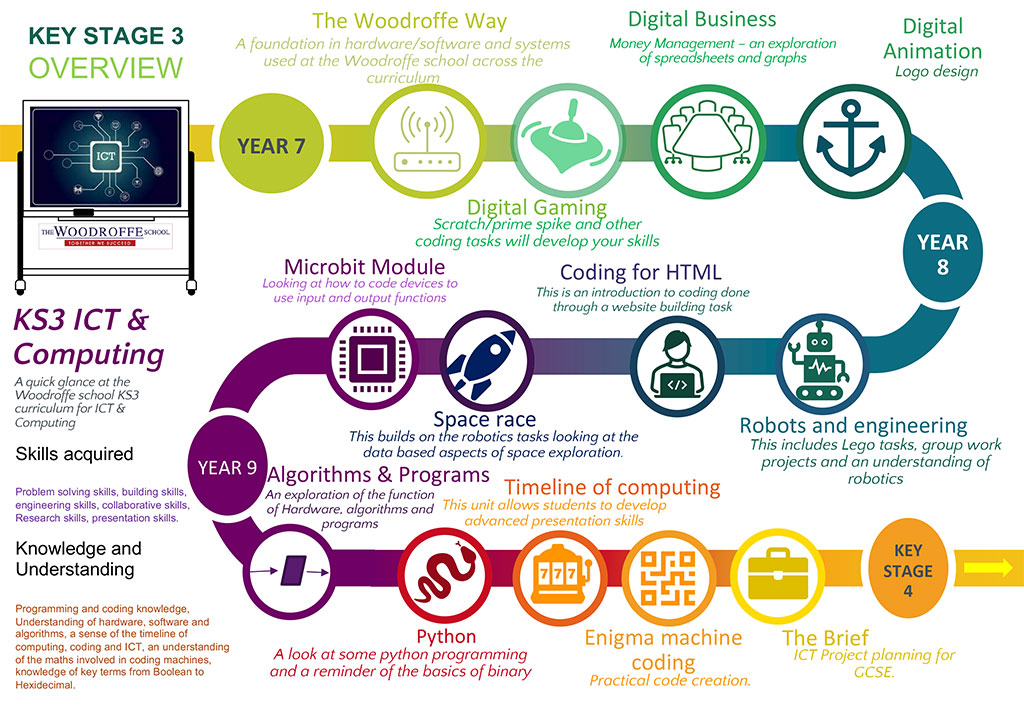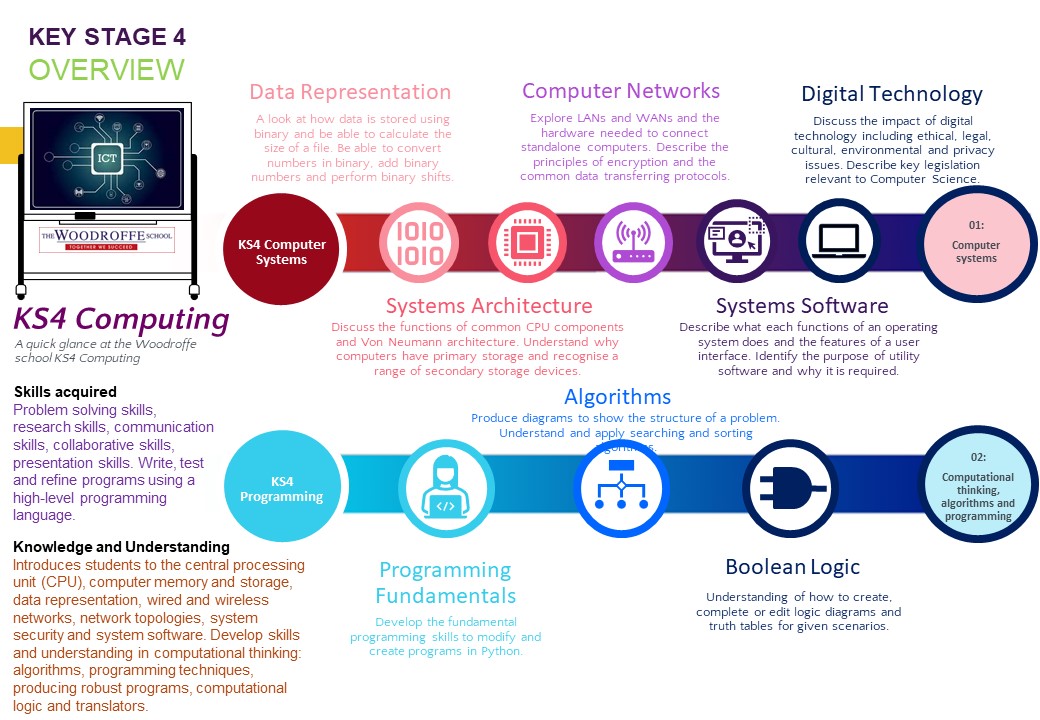Computing
All students follow an engaging computing experience in years 7 – 13 which prepares them for life in the digital age. This enables them to learn the core Computing and ICT skills needed during their education and also allows them to constantly refine the computing methods necessary to shape the future of technology.
Students use a range of software and learn numerous programming languages which challenges students to bring coding and engineering experiences to life in real time.

Intent
All students follow an engaging computing experience in years 7 – 13 which prepares them for life in the digital age. This enables them to learn the core Computing and ICT skills needed during their education and also allows them to constantly refine the computing methods necessary to shape the future of technology. Students use a range of software and learn numerous programming languages which challenges students to bring coding and engineering experiences to life in real time. Our use of Lego hardware enables students to explore programming language and tactile problem-solving within lessons. Students have the chance to use their growing expertise to develop solutions to increasingly complex coding problems year-on-year. Our curriculum design aims to encourage enthusiasm for the subject whilst preparing students for future learning and careers.
Implementation
Throughout their time in Computing students will learn to interact with a wide array of digital tools in a vertically integrated curriculum. These range from tools needed on an everyday basis like use of email, spreadsheets and data analysis to the tools needed to create hardware and coding solutions to given tasks and problems. Students also learn a range of computational methods which develop their problem-solving and resilience. Students are constantly challenged to improve their knowledge in this subject which also assists their development in other subject areas and prepares them for their future.
Impact
Computing skills are an essential part of modern life and it is vital that we continue to deliver high-quality lessons which both focus and enthuse students to realise their potential. We regularly refine and update our schemes of work to ensure that they are suitably rigorous to keep up with changes in technology and what students will need to know for their lives outside of Woodroffe. Our students will leave us as confident and adaptable learners that are able to use their skills in a range of areas. This is measured both in terms of grades, computer literacy and the capability of our students to become responsible digital citizens.
Year 7
In Year 7 students are introduced to a number of new pieces of software and ways of working. Students start by looking at passwords and security and then move on to emails. For many students this is the first email they have had, so they learn all about formal and informal emails and pitfalls of getting this wrong. Students then start to program the computer using Go Control (Flowcharts), before moving onto Scratch to program games of their own. Students also spend time looking at the reliability of online information – you’d be surprised how many students will believe anything they read!
Students then work on spreadsheet skills to model business problems, these include; Profit, Revenue, Sales and Costs. The final unit of the year is very creative and gets the students to produce animated logos which represent them. Students leave the year feeling much more ICT confident and ready to tackle even more challenging problems in Year 8.
Year 8
In Year 8 students have a number of projects that introduce them to coding. They use PICAXE to program a microcontroller that can be used to operate/control various domestic appliances. A Lego model is used to simulate the lighting/heating systems that one might have on their mobile device. Students also study the role of the Mars Rover projects in helping scientists to understand how information is gathered from other planets using computers. Lego models are engineered and students must program their ‘Rovers’ to complete a series of tasks that they would expect to have to perform in real life space exploration scenarios.
Year 9
In Year 9 students work on engineering driverless vehicles using Lego. They explore all the key concepts involved in the future of automated travel and learn how to program the Mindstorm CPU to utilise peripheral devices such as ultrasonic sensors, buttons, gyroscopic sensors and light detectors. Looking at real life examples of driverless travel such as the Docklands Light Railway, students explore coding/programming principles that make use of loops, switches, variables and arrays to build faultless functionality into their vehicle. Having learned the skills necessary to create safe, reliable automated transport students engage in robot wars with very different results.
Videos
Years 10 & 11
In this key stage our students follow a series of lessons which aim to build on their coding experience from Years 7 to 9, enabling them to tackle and solve the level of challenge presented by the GCSE style programming tasks and algorithmic problems. The planned learning activities are designed around the three component parts of OCR’s GCSE Computer Science qualification and prepare them for the two written summer examination papers at the end of the course. In the summer of their Year 11, there are two equally-weighted papers based on the following components:
Component 1: Computer systems (50%)
This Introduces students to the central processing unit (CPU), computer memory and storage, wired and wireless networks, network topologies, system security and system software. It also looks at ethical, legal, cultural and environmental concerns associated with computer science.
Component 2: Computational thinking, algorithms and programming (50%)
Students apply knowledge and understanding gained in component 1. They develop skills and understanding in computational thinking: algorithms, programming techniques, producing robust programs, computational logic, translators and data representation. The skills and knowledge developed within this component will support the learner when completing their programming project.
Programming Project
Students use OCR tasks to demonstrate their practical ability in the skills developed in components 1 and 2. In a controlled environment they will, define success criteria from a given problem, and then create suitable algorithms to achieve success criteria. Students then code their solutions in a suitable programming language, and check its functionality using a suitable and documented test plan.
The course is for students that relish the challenge of coding and like problem solving and want to extend their knowledge in this field. It is a subject that has strong links with mathematics and science, and is a good foundation for those that want to study Computer Science, or related subjects at A level.


